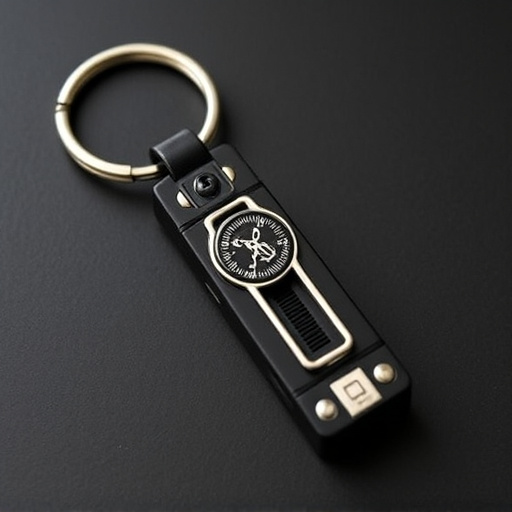Selecting the right metal for a Tactical Keychain Alarm With Light is crucial for its durability, impact resistance, and corrosion protection in various weather conditions. High-quality stainless steel (304 or 410 grade) offers exceptional corrosion resistance, while harder alloys enhance impact tolerance. An ergonomic design with comfortable grip, balanced length, textures for traction, and a stylish yet durable metal choice makes this keychain an ideal everyday carry tool and emergency solution.
In the realm of self-defense accessories, a tactical keychain alarm with light stands out as a multifaceted tool. This compact device combines security, visibility, and convenience, making it an indispensable everyday carry item. Choosing the right metal for durability and corrosion resistance is paramount; options like stainless steel, aluminum, and brass each offer unique advantages. An ergonomic grip design ensures secure handling, while tactical textures mitigate slipping. Integrating alarm and light functionality necessitates selecting reliable components and strategic placement for optimal performance. Balancing size and weight with robust features is key to a functional yet minimal keychain.
- Choosing the Right Metal for Durability and Corrosion Resistance
- – Discussion on the importance of metal selection for keychains
- – Comparison of common metals used in keychains (stainless steel, aluminum, brass)
- Designing an Ergonomic Grip for Secure Handling
Choosing the Right Metal for Durability and Corrosion Resistance
When designing a tactical keychain alarm with light, selecting the appropriate metal is key to ensuring durability and longevity. For such a functional accessory, corrosion resistance is paramount, especially when exposed to varying weather conditions and frequent use. Opting for high-quality stainless steel is an excellent choice as it offers exceptional resistance to rust and corrosion, making it ideal for outdoor enthusiasts and those seeking a reliable everyday carry tool.
Different grades of stainless steel provide varying levels of strength and finish, so consider the intended use. For instance, 304 grade stainless steel is widely used in applications requiring superior corrosion resistance, while 410 grade might be more suitable for lower-cost options, still offering decent durability. Remember, the right metal choice will contribute significantly to the overall performance and reliability of your tactical keychain alarm with light.
– Discussion on the importance of metal selection for keychains
When designing a tactical keychain, such as a Tactical Keychain Alarm With Light, one of the most critical factors to consider is the metal selection. The chosen metal plays a significant role in determining the overall performance and durability of the accessory. For keychains intended for everyday carry or emergency use, robust metals like stainless steel are often preferred due to their superior strength and resistance to corrosion. These materials ensure that the keychain maintains its integrity over time, even with frequent use and exposure to various environments.
Additionally, the metal’s hardness is essential, especially if the keychain includes functional features like a built-in alarm or light. Harder metals, such as high-quality alloys, can withstand impact and scratching better, ensuring these tactical functions remain reliable. The right metal choice not only enhances the keychain’s functionality but also contributes to its overall aesthetic appeal, making it a practical and stylish accessory for those seeking added security and preparedness.
– Comparison of common metals used in keychains (stainless steel, aluminum, brass)
When choosing a metal for your tactical keychain alarm with light, consider stainless steel, aluminum, or brass—each offering unique advantages and drawbacks. Stainless steel is renowned for its durability and resistance to corrosion, making it an excellent choice for outdoor enthusiasts and those in harsh environments. Its strength ensures the keychain retains its shape over time, even with frequent use. However, it may be slightly heavier than other options, which could impact the overall weight of your tactical accessory.
Aluminum keychains are lightweight yet robust, ideal for those seeking a more discreet carry option without sacrificing sturdiness. This metal is also corrosion-resistant but might not hold up as well to frequent impact or extreme conditions compared to stainless steel. Brass, known for its golden hue and excellent machinability, offers a balance between weight and durability. While it may require more maintenance to prevent tarnishing, brass keychains are popular among collectors and those who appreciate the aesthetic appeal of their tools.
Designing an Ergonomic Grip for Secure Handling
When designing a tactical keychain alarm with light, prioritizing an ergonomic grip is paramount for ensuring secure handling. The keyring should be shaped to comfortably fit within the user’s hand, promoting a firm grasp. Incorporate textures or ridges along the surface of the ring to enhance traction and prevent slipping, especially in challenging conditions. This design aspect ensures the keychain remains under control during sudden movements or when wet hands are involved.
Ergonomics also dictates considering the length of the keychain. A well-designed tactical keychain should extend just far enough to reach and operate locks effectively without causing strain on the user’s wrist or hand. Balancing functionality with comfort, you can create a secure carrying solution that enhances everyday convenience and personal safety features like the alarm and light.
When crafting a durable and functional tactical keychain alarm with light, prioritizing the right metal and ergonomic grip design is key. Stainless steel offers superior corrosion resistance, while aluminum provides lightweight strength. Brass, though less common, adds a touch of elegance and durability. For secure handling, consider grip textures or contoured shapes that prevent slipping. These design tips ensure your keychain not only looks tactical but also feels comfortable and performs reliably in various situations.
